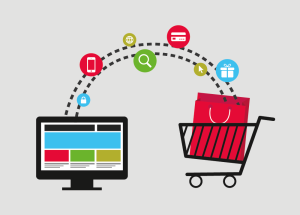You might also like our related post: E-commerce solutions that scale, or other articles about e-commerce.
In this blog post we will briefly discuss three general types of e-commerce platforms (methods of selling on-line), with the aim of helping you demystify the huge offering out there:

- Large, feature-rich web applications, stalwarts like OSCommerce, Prestashop and Magento.
- Pay monthly SAAS (Software as a Service) models, perfect for non-developers and designers, like Shopify and LemonStand.
- Addons/Plugins to already existing platforms, providing a solution somewhere in the middle of the above two, like Woocommerce or VirtueMart.
Selling on the web in 2016 has never been easier, but with so much to choose from before making an investment on a platform, it is important to understand the market.
Large Web Applications
One of the first ways to get on-line was by downloading an existing project, then installing it on your own server. A developer would then modify the project’s code to make it suitable for you, the client.
To make this quicker, in time, extensions became the norm. Developers packaged up frequently requested modifications, and these could be added to your site quickly. This method was used for years to get your store online; one of the first to my memory was OSCommerce, and was released in the year 2000.
To this day we still use a project like this, namely, Magento for specific projects; so, would it be the right choice for your company?
The benefits? Magento has many integration options. If your company needs to use the extended functionality, an application like Magento may be your only option at this point. If you are using the extended functionality, maintaining a site like Magento could well be the most cost effective solution.
The drawbacks? Large projects are difficult to maintain and upgrade (due to all the changes developers make), contain bugs and frequently need patching for security reasons. They are often too feature-rich, containing a vast array of functionality which may not be required for the small to medium sized business. As a result, the main reason to use this type of project is lost, and the small business owner is left with all the risks and none of the benefit!
SAAS E-Commerce
Although the ‘Large Web Application’ method initially seemed like an attractive option for many, it became apparent this was not a great way for most small businesses to operate online. As a result many turned to third party websites to sell their wares, including Ebay, Amazon or niche sites like Etsy and ASOS Marketplace.
These services took care of the security and made it cheaper in the short term, but there was little control of the aesthetic and no control of the cost; consequently as many businesses matured they started looking for an alternative.
Sites like Shopify then started to emerge in order to fix these problems, and are still a popular choice for many – so, would this be the right choice for your company?
The benefits? These platforms give the client more control over how the site looks, and that charge a manageable monthly fee, whilst taking care of all the security and hosting concerns.
The drawbacks? Whilst a growing market, as a company expands this model inevitably hits the same issues as on the third party platforms. After all, this too is a third party site; the concerns are allayed for a time, but sooner or later the platform simply will not offer something that becomes important, such as integration with internal systems, certain pricing structures or perhaps the platform’s costs may increase.
E-Commerce Plugins
For the past decade, an emerging sector was bubbling underneath.
Many small to medium businesses already had websites on Content Management System platforms like WordPress or Joomla!, so open source projects to extend the functionality of these sites became a cost effective way of selling online.
Their initial feature offering was quite small, but with the ability to essentially write plugins for plugins, the development community has made this form of selling online both feature-rich and affordable.
Here at Holler Marketing, we now use Woocommerce for the majority of our e-commerce projects; so, would it be the right choice for your company?
The benefits? When used properly, i.e. designed and developed in line with the pre-defined standards, Woocommerce can be a powerful, quick and cost effective choice. It can help your business combine its website, blog and shop seamlessly, giving your company a great all round web presence.
The drawbacks? It’s easy to do it wrong. WordPress can ‘hobble along’ with poorly coded themes and plugins. It is possible to modify the site in ways which are non-compliant, and so a site over the months and years can become a heap of code, rather than then secure, updated e-commerce platform you need it to be.
However, when handled by an experienced web development agency, Woocommerce can often prove to be an excellent choice for most small to medium sized businesses.
As you can see, there is merit in each of the 3 main types of e-commerce website, however there are of course also drawbacks. The important thing is to contact a web design agency with knowledge and experience of the different offerings, so that you can have a balanced and unbiased discussion about the best choice for your business. In addition, make sure your choice of agency can also deliver an engaging website which accurately represents your business, is well designed and – most importantly – will bring in sales.
Holler Marketing are experienced in all aspects of website design and development, and have worked with clients on e-commerce projects in a wide variety of market sectors – call us on 01964 542916 to discuss your requirements, email us direct at [email protected], or visit the web projects page on our website for more information.

